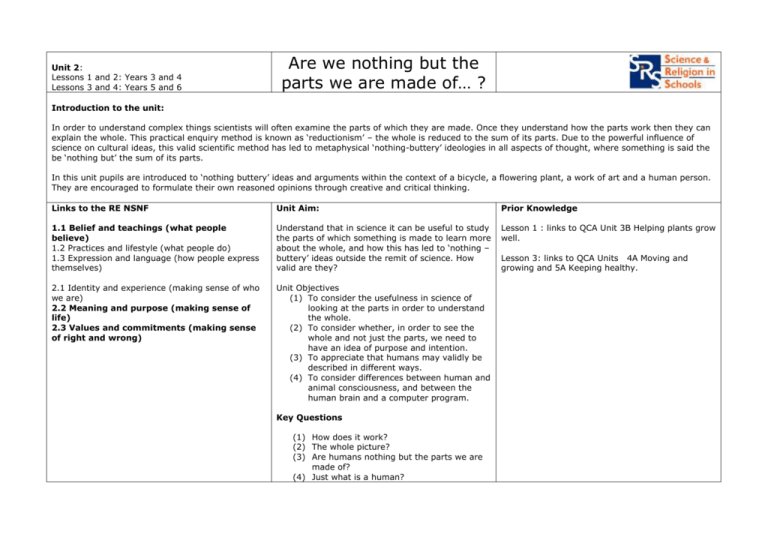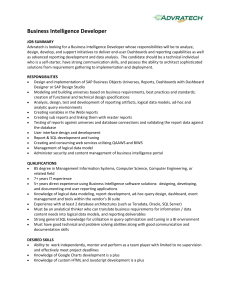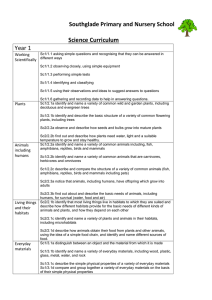Unit Proforma and links to RE and science curricula
advertisement

Unit 2: Lessons 1 and 2: Years 3 and 4 Lessons 3 and 4: Years 5 and 6 Are we nothing but the parts we are made of… ? Introduction to the unit: In order to understand complex things scientists will often examine the parts of which they are made. Once they understand how the parts work then they can explain the whole. This practical enquiry method is known as ‘reductionism’ – the whole is reduced to the sum of its parts. Due to the powerful influence of science on cultural ideas, this valid scientific method has led to metaphysical ‘nothing-buttery’ ideologies in all aspects of thought, where something is said the be ‘nothing but’ the sum of its parts. In this unit pupils are introduced to ‘nothing buttery’ ideas and arguments within the context of a bicycle, a flowering plant, a work of art and a human person. They are encouraged to formulate their own reasoned opinions through creative and critical thinking. Links to the RE NSNF Unit Aim: Prior Knowledge 1.1 Belief and teachings (what people believe) 1.2 Practices and lifestyle (what people do) 1.3 Expression and language (how people express themselves) Understand that in science it can be useful to study the parts of which something is made to learn more about the whole, and how this has led to ‘nothing – buttery’ ideas outside the remit of science. How valid are they? Lesson 1 : links to QCA Unit 3B Helping plants grow well. 2.1 Identity and experience (making sense of who we are) 2.2 Meaning and purpose (making sense of life) 2.3 Values and commitments (making sense of right and wrong) Unit Objectives (1) To consider the usefulness in science of looking at the parts in order to understand the whole. (2) To consider whether, in order to see the whole and not just the parts, we need to have an idea of purpose and intention. (3) To appreciate that humans may validly be described in different ways. (4) To consider differences between human and animal consciousness, and between the human brain and a computer program. Key Questions (1) How does it work? (2) The whole picture? (3) Are humans nothing but the parts we are made of? (4) Just what is a human? Lesson 3: links to QCA Units 4A Moving and growing and 5A Keeping healthy. Links to the Science NC Key Quotes Teacher Resources 1 Ideas and evidence in science Sc1.2 Investigative skills Machine analogy breaks down when it comes to understanding the growth and development of organisms…the fact that machines are like artificial organisms does not mean that organisms are nothing but machines. The Rebirth of nature – the greening of science and God (Park Street Press 1991) by Rupert Sheldrake p.103 A Guide to Science and Belief (Lion) by Michael Poole Sc2.1 Life processes Sc2.2 Humans and other animals Sc2.3 Green Plants Sc2.4 Variation and classification Sc2.5 Living thing in their environment Sc3.1 Grouping and classifying materials Sc3.2 Changing materials Sc3.3 Separating mixtures of materials Sc4.1 Sc4.2 Sc4.3 Sc4.4 Electricity Forces and motion Light and sound The Earth and beyond Science and Belief (Templeton Foundation Press) by Russell Stannard The New Flatlanders (Highland) by Eric Middleton The price to be paid for continually reducing in a search for simplicity can be to lose sight of the importance of the way the basic ‘building bricks’ are arranged. The order gives rise to properties which the ‘building bricks’ themselves do not have. A Guide to Science and Belief (Lion) by Michael Poole p.46 The notion that there is no more to a person than the pile of chemicals that happens at any particular time to make up one’s body, though useful in certain and limited contexts, cannot in other respects be regarded as adequate. Science and Belief (Templeton Foundation Press) by Russell Stannard p. 116 Determinism was most explicitly defended by Laplace, who claimed that if we knew the position and velocity of every particle in the universe, we could calculate all future events. His claim is reductionist in assuming that the behaviour of all entities is determined by the behaviour of their smallest components. When Science meets Religion (SPCK) by Ian Barbour p.71 Active Assessment by Naylor and Keogh (containing a graphic organiser for whole-parts relationships) Classroom Resources Recommended: Lesson 1: bicycle, clock, jigsaw Lesson 2: oil painting (original or print), art materials, examples of abstract art, shoe, toy car, tennis racquet (or substitutes) Lesson 3: diagrams or models of skeleton and of human internal organs, globe Lesson 4: diagram of human brain, computer microchip Links to other parts of the NC Learning Styles / Intelligences ICT opportunities Speaking and Listening Literacy Numeracy Foundation subjects - Art Thinking Skills Creativity SMSC Visual / Auditory /Kinaesthetic Linguistic intelligence ("word smart"): Logical-mathematical intelligence ("number/reasoning smart") Spatial intelligence ("picture smart") Bodily-Kinaesthetic intelligence ("body smart") Musical intelligence ("music smart") Interpersonal intelligence ("people smart") Intrapersonal intelligence ("self smart") Naturalist intelligence ("nature smart") Pupils may be encouraged to conduct research using the internet, especially in homework or extension activities. For Group of Seven art: www.mcmichael.com In lesson 4 they are encouraged to think critically about the nature of computer ‘thought’. For Van Gogh art: www.art.com Vincent Van Gogh Gallery.







